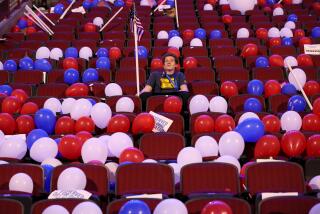A Diverse, Inclusive Miniseries
PHILADELPHIA — When the lights hit the stage at the Republican Party’s convention here Monday night, television cameras will focus on a class of mostly Latino students chanting a rap-like routine borrowed from their Houston classroom.
Flying the students to Philadelphia is one way that Republicans planning the nomination of George W. Bush hope to pack their events with political messages that market the Texas governor as an inclusive candidate who places a premium on education and the plight of poor children.
Republicans hope the lineup’s diversity can help the party win more minority voters than usual, especially Latinos. But the faces being spotlighted at the convention are designed in large part to convey a progressive image to white moderate swing voters, even as Bush’s policies on taxes, abortion and many other issues hew to traditional Republican stands.
In this and other ways, GOP leaders are shaping their convention with television in mind, even though the networks are not planning to air more than a scant three to five hours of the four-day affair.
Like producers of an awards show, the architects of the GOP gathering have mapped out camera sight lines in Philadelphia’s First Union Center sports arena and have scripted minute-to-minute when applause should start and fade and when music should cue network anchors to cut away for commercial breaks.
All of the planning is to maximize the exposure for images supporting Bush’s latest campaign mantra, “Renewing America’s purpose together.”
A series of four-minute videos called “profiles in compassion” will showcase privately funded health and education programs and convey the message that Bush is attentive to policy terrain traditionally friendly to Democrats. One piece, for example, profiles a Palo Alto program started by Bush’s foreign policy advisor, Condoleezza Rice, that’s designed to keep at-risk kids interested in school.
A speech by retired Gen. Norman Schwarzkopf, beamed from the deck of a battleship docked in Camden, N.J., is intended to remind viewers of the Persian Gulf War, when the GOP last occupied the White House. And the expected blues-rock set by guitarist Jimmie Vaughan tells convention-watchers that the party has progressed since the days when its headline entertainment was the Oak Ridge Boys.
But a major focus this year is on portraying Bush as a “big tent” Republican, shaking off memories of the 1992 convention, when Pat Buchanan stole the spotlight from Bush’s father by declaring the nation was divided by a “cultural war.”
Monday’s session, for example, will open with an appearance by the only black Republican state lawmaker in Virginia, Assemblyman Paul C. Harris. Tuesday night’s speakers include Rep. Jim Kolbe (R-Ariz.), the only openly gay Republican in Congress.
A GOP make-over of the convention hall was itself inspired by an eye on theatrics. Instead of the standard dais, the speakers will address the crowd from a stage barely 7 feet high with a retractable podium that sinks into the floor.
Bush, on a six-state tour that will lead him to the convention, will address the gathering via satellite each night before Thursday, when he accepts the nomination.
“The governor’s kind of your lead character, and you wouldn’t just have him appear in the fourth act,” said Bush media consultant Russ Schriefer, comparing the event to a four-day miniseries.
But convention planners are working to do more than keep Bush’s face on the air. They’ve assembled a “surrogate program” to book Bush lieutenants on broadcast, cable and Web shows.
The party will also beam satellite interviews with Bush supporters to local stations that don’t send reporters to the convention. “The one thing we’re looking to do is to make sure we have people available at 1 o’clock in the morning for California,” Schriefer said amid last-minute preparations last week.
Television reporters chafe at the notion that the party is using their broadcasts as an extended advertisement. But others involved in the logistics find it harmless.
“I don’t consider that manipulating the media, I consider that allowing the media to do their job,” said a network producer who spoke on condition of anonymity.
The question facing both the parties and the networks is whether anyone will watch. Ratings for the conventions have fallen almost steadily since 1980. A survey released Thursday by the Pew Research Center for the People and the Press found that only 34% of the public is interested in following the convention, down from 44% in 1996.
Those who tune in will see a convention focused on promoting the candidate instead of the party.
Among the GOP-produced visuals, for example, will be the now-standard biographical film covering the nominee’s life. The film, running about 10 minutes, was done by Bush media consultant Mark McKinnon.
“This whole convention is designed . . . to give the images associated with who we are and what we stand for,” said Leslie Goodman, a California delegate who is running the in-house booking operation. “We’ll have to let the voters decide whether the program is compelling enough to attract them.”
More to Read
Get the L.A. Times Politics newsletter
Deeply reported insights into legislation, politics and policy from Sacramento, Washington and beyond. In your inbox three times per week.
You may occasionally receive promotional content from the Los Angeles Times.










